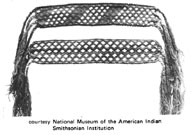
| Sashes and Garters comments by Rick Obermeyer (Dec., 1990) in 19th Century Seminole Men`s Clothing
|

| Sashes and Garters comments by Rick Obermeyer (Dec., 1990) in 19th Century Seminole Men`s Clothing
|
There are scant, if any, written descriptions
of Seminoles wearing fingerwoven sashes and garters. But there
is ample evidence from illustrations and from surviving examples
that not only was flngerweaving common, it was necessary for a
chief's complete attire. Seven of the nine Seminole portraits
in McKenney-Hall clearly show fingerwoven sashes. An eighth portrait,
"Foke Luste Hajo," has a narrow black sash that is a
"probable" because it has seed beads along its outside
edges. The sash colors in the McKenney-Hall portraits are:
| PORTRAIT | MOTIF | WOOL COLORS | ||||
| Osceola (sash) | diamonds | black | dark | (w/white beads) | ||
| (garters) | diamonds | black | blue | (no beads shown) | ||
| Foke Luste Hajo | solid(?) | black | (w/white beads) | |||
| Itcho Tustennuggee | W' s | black | red | (w/white beads) | ||
| Julcee Mathla | W's | black | white | (w/white beads) | ||
| Neamathla | W' s | black | (w/white beads) | |||
| Tukosee Mathla (sash) | chevrons | black | blue | white(?) | (w/white beads) | |
| (garters) | diamonds | black | blue | (w/white beads) | ||
| Yahahajo | diamonds | black | blue | (w/white beads) | ||
| Billy Lowlegs | diamonds | ? | (w/white beads) | |||
| photo, "old Tallahassee" (1890s) | diamonds | black(?) | (w/white beads) | |||
Neither the design nor the colors of
Billy Bowlegs' sash can be determined from the his McKenney-Hall
lithograph. An 1858 photo of him (Fig. 310, Fundaburk, 1956) more
clearly shows the pattern and the use of beads. It's easy to surmise
from the black and white photo that at least black was used, but
other dark colors (if any) are conjectural.
Osceola's sash does not appear in either
of George Catlin's painting of him, but it is verified in the
Robert John Curtis portrait (Goggin, 1955, and Fig. 291, Fundaburk,
1956), and by an example in the Florida Museum of Natural History,
Gainesville, purported to be his.
Some other examples of fingerwoven sashes
are:
| PORTRAIT | MOTIF | WOOL COLORS | ||||
| Fl.Mus.Nat.Hist.,Gainesvllle "Osceola's" | diamonds | black | dark blue | (w/white beads) | ||
| (1830's) | cmplx.chev. | blue | red | (w/white beads) | ||
| (1840's) | diamonds | black | red | (w/white beads) | ||
| Milwaukee Public Mus. | diamonds | black | red | (w/white beads) | ||
| "No-Kush-Adjo" (Fig. 300, Fundaburk, 1956) | diamonds | ? | (w/white beads?) | |||
| photo, "Old Tallahassee" (1890's) | diamonds | black(?) | (w/white beads) | |||
| Am.Mus.Nat.Hist.,NY (late 19th cent.belt) | diamonds | black | blue(?) | red | (w/white beads) | |
There are also at least two examples
in the Museum of the American Indian, Heye Foundation, one of
which was collected before 1840 (Spec. 22/9559) and the other
at least by 1906 (Spec. 1/8201).
The number of tassel cords varies from
three to eight on each end. The tassels are heddle-woven, often
finished off by clumping into a short three-strand braid, the
whole cord and tassel about .6cm wide by 115cm to 160cm long.
The tassels on early 19th century examples are about the length
of a little finger or smaller; the tassels on later examples can
be as long as a hand.
If Catlin doesn't help us out much with
fingerwoven sashes in his Seminole portraits, he does provide
information for a waist band and some garters. The full length
portrait of Osceola indicates two or more waist sashes, judging
from the number of ties hanging loose. Seminoles did occasionally
make belts by beading designs onto wool or buckskin, with added
heddle woven tassel cords, but Osceola doesn't appear to be wearing
something like that, even though no sash patterns are discernible.
Specks of white paint indicate white beads used in a way that
could only be included in fingerweaving, here done with red and
blue yarns.
Catlin provides us information on fingerwoven
garters:
| PORTRAIT | MOTIF | WOOL COLORS | ||||
| Osceola | diamonds | black | blue(?) | (w/white beads) | ||
| Mick-E-No-Pah | diamonds | black | blue | (w/white beads) | ||
The designs and construction of Osceola's
and Mick-E-No-Pah's garters are identical, so it would be easy
to assume that the colors were also Identical. The McKenney-Hall
lithograph shows yellow ties for Osceola's garters, but besides
being atypical, this detail color does not fit in with how these
things are made. So, the yellow on the ties might be viewed with
suspicion. True, one of Osceola's garters has survived, "but
they have faded so badly that the original color cannot be determined;
they could have been the blue and black shown in (McKenney-Hall)"
(P. 183-84, Goggin, 1955).
Some other examples of garters are:
| PORTRAIT | MOTIF | WOOL COLORS | ||||
| Fl.Mus.Nat.Hist., Gainesville (early 19th cent.?) | diamonds | black | red | (w/white beads) | ||
| Denver Art Museum (Spec. 1965.226; Fig. 17, Conn, 1979) (mid-19th cent.) | diamonds | black | (w/white beads) | |||
| photo, "old Tallahassee" (1890s) | diamonds | black(?) | (w/white beads) | |||
The Museum of the American Indian, Heye
Foundation, has a set of garters (Spec. 1/8204). The two in the
set are the same size, and have the same diamond design, but there
are enough slight differences in construction to make one wonder
if they were, in fact, originally the same set, or if they are
each from two different sets.

| While the sashes have heddle woven tassel cords, garters appear to have merely braided 8" to 10" fringes, usually four on each end.
Fingerwoven garters and sashes were still worn to the end of the 19th century, but mostly only by older men. |
As wool leggings were discontinued in
favor of buckskin ones, so were fingerwoven garters no longer
needed. Fingerwoven sashes were replaced by sashes beaded on a
heddle loom, though with the same kinds of larger tassels and
heddle woven cords added on. These heddle beaded sashes with tassel
cords are still made and used at the Green Corn Dances. A contemporary
example was shown to the author at the Miccosukee Reservation
in 1987.

The idea of fingerweaving may boggle
the mind of a Seminole hobbyist. Although time consuming, it's
no more so than loom beading, and it's much easier to do than
it appears. And it helps that the fingerwoven part of a sash need
not be long enough to go from hip to hip. The fingerwoven section
of Seminole sashes might be 2" to 3" wide and about
3' long, all the rest of the 7' to 8' length being cords and tassels.
A series of three articles on fingerweaving by Richard Conn explains
how to make complicated "arrow," "f1ame,"
and "reflex arrow" designs. The reenactor might be relieved
to learn that he need not learn these complex weaves because the
Seminole never used them. So, only the first and most basic of
Mr. Conn's three articles are included here, which describes how
to make the "W" pattern.
Seminoles also used diamond patterns,
which can be made three different ways. Although diamonds were
common, and almost the only pattern used for garters, those instructions
are not yet included here.

Most of the McKenney-Hall pictures show
white beads included in the W patterns, and on the edges of the
heddle-woven tassels. The hobbyist should use 8/o size white "pony"
beads, and can get them threaded onto yarn by using a fingernail
of beeswax to twist a half inch of one end into a hard thin point.
The beads are left behind as the yarn is woven into the pattern,
How to do heddle-woven fringes will be
described in the future. For now, a hobbyist can finish off. his
sashes with clumped three-ply braided sashes.
Color choices seem to be pretty limited.
It should be apparent from this review that Seminoles were as
conservative with their flngerweavlng colors and designs as with
most other items of their apparel. Only two of four are used in
the Seminole portraits of McKenney-Hall: red, black, royal or
dark blue, and white.
How much wool is needed? The author once
made a sash that seemed to work out to be the right size using
64 strands, each about 17 feet long.
Granted, there is a problem finding real
wool yarn in Florida. Acrylic yarns are fine for learning and
for practice pieces. But the time needed for a full piece really
is worth tracking down real wool yarn to use for it. Mid-size
wool knitting yarn is readily available for $4 or $5 a skein in
most Northern cities, and you'll only need two or three skeins
for a sash. Try to locate a Yankee friend or relative to help
you out.
Following is the first of three articles by Richard Conn, from the 1972 6(10):2-5 issue of American Indian Crafts and Culture., pgs. 14-15. It is included with his permission.
REFERENCES
Conn, Richard
1972 FINGERWEAVING-Part 1. American Indian
Crafts and Culture. 6(10):2-5, 14-15.
1973a FINGERWEAVING-Part 2. American Indian Crafts and Culture. 7(1):2-7.
1973b FINGERWEAVING- Part 3.Amerlcan Indian Crafts and Culture. (2):2-7.
1979 NATIVE AMERICAN ART IN THE DENVER ART MUSEUM. University of Washington Press, Seattle and London.
Fundaburk, Emma Lila
1958 SOUTHEASTERN INDIANS LIFE PORTRAITS.
Scarecrow Reprint Corporation, Metuchen, NJ. 1969.
Goggin, John M.
1955 "Osceola: Portraits, Features,
and Dress," The Florida Historical Quarterly, XXXIII: 3 &
4, Gainesville.
McKenney, Thomas L. and James Hall
1836-44 Portrait Gallery of American
Indians. Ed. James D. Horan. Crown Publishers, 1986.
Complete Index to Articles in 19th Century Seminole Mens Clothing

|
Text and Graphics
© 1994 - Tara Prindle unless otherwise cited. |